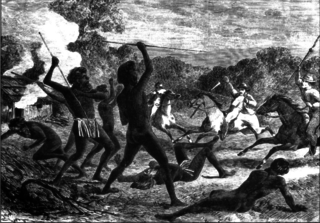
The Myall Creek massacre at Myall Creek near the Gwydir River, in the central New South Wales district of Namoi, involved the brutal killing of at least twenty-eight unarmed Indigenous Australians by eleven colonists on 10 June 1838 at the Myall Creek near Bingara, Murchison County, in northern New South Wales. After two trials, seven of the eleven colonists were found guilty of murder and hanged.
The Kalkadoon are descendants of an Indigenous Australian tribe living in the Mount Isa region of Queensland. Their forefather tribe has been called "the elite of the Aboriginal warriors of Queensland". In 1884 they were massacred at "Battle Mountain" by settlers and police.
Warluwarra is an extinct Australian Aboriginal language of Queensland. Waluwarra has a traditional language region in the local government area of Shire of Boulia, including Walgra Station and Wolga, from Roxborough Downs north to Carandotta Station and Urandangi on the Georgina River, on Moonah Creek to Rochedale, south-east of Pituri Creek.

Corymbia aparrerinja, commonly known as ghost gum, is a species of tree that is endemic to Central Australia. It has smooth bark, lance-shaped or curved adult leaves, flower buds in groups of three or seven, white flowers and cup-shaped to cylindrical fruit.

The Australian frontier wars is a term applied by some historians to violent conflicts between Indigenous Australians and white settlers during the British colonisation of Australia. The first fighting took place several months after the landing of the First Fleet in January 1788 and the last clashes occurred in the early 20th century, as late as 1934. A minimum of 40,000 Indigenous Australians and between 2,000 and 2,500 settlers died in the wars. However, recent scholarship on the frontier wars in what is now the state of Queensland indicates that Indigenous fatalities may have been significantly higher. Indeed, while battles and massacres occurred in a number of locations across Australia, they were particularly bloody in Queensland, owing to its comparatively larger pre-contact Indigenous population.

Urandangi is an outback town in the locality of Piturie in the Shire of Boulia, Queensland, Australia.

Carandotta Station most commonly referred to as Carandotta also often spelled as Carrandotta, is a pastoral lease that operates as a cattle station in Queensland, Australia. It is within the localities of Carrandotta and Piturie in the Shire of Boulia.

Deebing Creek Mission is a heritage-listed former Aboriginal reserve at South Deebing Creek Road, Deeping Heights, City of Ipswich, Queensland, Australia. It was built from c. 1887 to c. 1915. It is also known as Deebing Creek Aboriginal Home, Deebing Creek Aboriginal Mission, and Deebing Creek Aboriginal Reserve. It was added to the Queensland Heritage Register on 24 September 2004.

Purga Aboriginal Cemetery is a heritage-listed cemetery at Carmichaels Road, Purga, City of Ipswich, Queensland, Australia. It was added to the Queensland Heritage Register on 18 September 2008.

Murrumba Homestead Grounds is a heritage-listed site at 38 Armstrong Street, Petrie, Moreton Bay Region, Queensland, Australia. It was added to the Queensland Heritage Register on 16 February 2009.

The Yugambeh are a group of Australian Aboriginal clans whose ancestors all spoke one or more dialects of the Yugambeh language. They are also alternatively known as the Chepara or the Mibin Their traditional lands are located in what is now south-east Queensland and the Northern Rivers of New South Wales, situated in the Logan City, Gold Coast, Scenic Rim, and Tweed City regions of Australia. Archaeological evidence indicates Aboriginal people have occupied the area for tens of thousands of years. By the time European colonisation began, the Yugambeh had a complex network of groups, and kinship.
The Yuwi or Yuibera are an Indigenous Australian people, originating from Mackay, Queensland, Australia.

Waverley is an outback locality in the Shire of Boulia, Queensland, Australia. In the 2016 census, Waverley had a population of 20 people.
The Mandandanyi are an indigenous Australian people of Queensland.
The Djaru people are an indigenous Australian people of the southern Kimberley region of Western Australia.
The Waluwara were an indigenous Australian people of the state of Queensland.

Myall Creek Massacre and Memorial Site is the heritage-listed site of and memorial for the victims of the Myall Creek massacre at Bingara Delungra Road, Myall Creek, Gwydir Shire, New South Wales, Australia. It was added to the Australian National Heritage List on 7 June 2008 and the New South Wales State Heritage Register on 12 November 2010.

Carrandotta is a locality in the Shire of Boulia, Queensland, Australia. In the 2016 census, Carrandotta had a population of 0 people.

Piturie is an outback locality in the Shire of Boulia, Queensland, Australia. In the 2016 census, Piturie had a population of 59 people. The town of Urandangi is within the locality.













